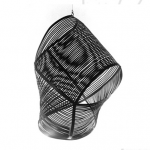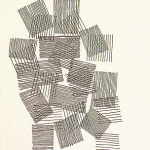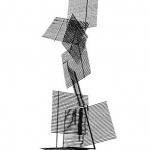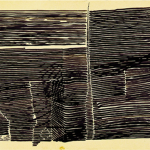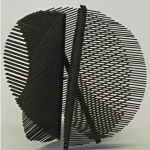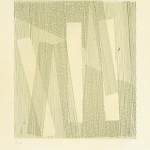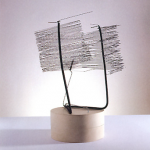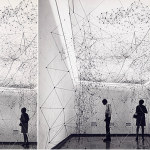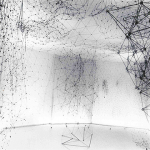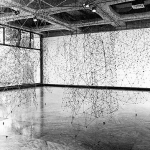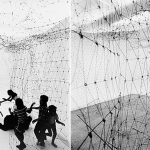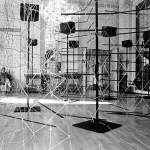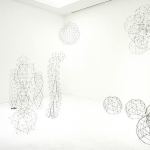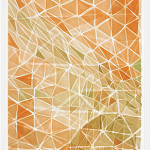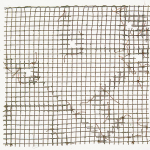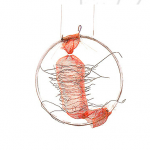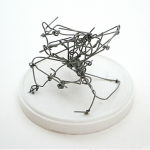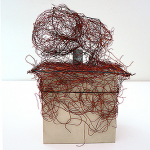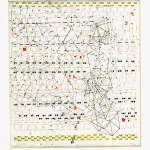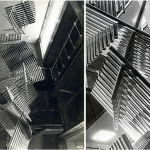Project Description
GEGO
(Gertrud Goldschmidt). Hamburg 1912 – Caracas 1994.
Gego was born in the German city of Hamburg in August 1912 and graduated as an engineer with a specialty in architecture at the University of Stuttgart, Germany, in 1938. One year later she emigrated to Venezuela.
In 1956 in Caracas, thanks to the encouragement of Alejandro Otero and Jesús Soto, Gego begins her production of three-dimensional work. As a parallel activity she takes up teaching, a job she kept up between 1958 and 1977 at several Venezuelan educational institutions such as: School of Fine Arts Cristóbal Rojas (1958-1959); School of Architecture, Universidad Central de Venezuela (1960-1967); Institute of Design, Fundación Neumann – INCE (1964-1977), of which she was a founding member.
In 1959 Gego works in the Iowa State University’s workshops and the Lasansky Workshop. Later, in the year 1960, she studies and works at the Threitel-Gratz Co. workshop in New York where she produces engravings and sculptures. That same year, in Caracas, Gego, together with other artists, participates in the creation of TAGA (Engraving Workshop). In 1963 Gego attends specialization courses in pedagogical systems at Berkeley University in California with a scholarship from the Consejo de Desarrollo Científico y Humanístico of Universidad Central de Venezuela. That same year she attends the Tamarind Lithography Workshop in Los Angeles and creates many engravings in the workshops of the Pratt Graphic Art Institute in New York. Between the years 1966 and 1967 she again studies and works at the Tamarind Lithography Workshop in Los Angeles.
As of 1967 the artist devotes her time to teaching and to the development of her fine art work in Caracas, where she dies on September 17, 1994.
The artist’s work
Although varied and changing, Gego’s work remains whole and related through the notions about space that the artist tackles. Her watercolors, drawings, engravings, paper weavings and sculptures are proof of a constant creative and experimental process. In all her work one can identify the enormous power of the line as a generating element. Between 1957 and 1969 Gego produces her work based mainly on equidistant strokes, a period which Iris Peruga, curator of the exhibition Gego 1955-1990 held at Museo de Bellas Artes in Caracas in 2000-2001, classifies and calls Parallel Lines. Her drawings, engravings and sculptures show her interest for space, transparency and structure, a fact that also pervades her work of architectural intervention.
As of 1969 Gego divests herself of rigid materials for the construction of her three-dimensional work. She starts to produce drawings with lines that cross each other forming flat and modulated nets. From then on she shapes different spaces according to the association and the links between the nets, creating a universe of connections. Proof of this are her Reticuláreas (Networks), Troncos (Trunks) and Esferas (Spheres) which characterize this phase of her work and for which she is best known. This period prepares the way for a freer transit in her artistic work, when in 1976 she abandons every idea of pre-conceived composition with the so-called Dibujos sin Papel (Drawings without Paper) and, later on, with her Bichitos (Little Beasts), for which she uses scrap materials in apparently arbitrary compositions.
Between 1988 and 1991 she develops the last phase of her work with her Tejeduras (Weavings), small compositions made with interwoven strips of paper, in which she synthesizes her encounters with space. In Caracas GEGO produced several large format works which are harmoniously integrated into architectural space.
GEGO’s awards and recognitions:
– First prize in Drawing, IV National Drawing and Engraving Exhibition, Facultad de Arquitectura y Urbanismo, Universidad Central de Venezuela, Caracas. 1962.
– Scholarship from the Consejo de Desarrollo Científico y Humanístico of Universidad Central de Venezuela to follow specialized studies in pedagogical systems related to architecture at North-American and European institutions. October 1962 – December 1963.
– Work scholarship “Artist Fellow”, Tamarind Lithography Workshop, Los Angeles, California. November – December 1966.
– First prize in Sculpture, XII Salón D’Empaire of painting and sculpture, Maracaibo. 1967.
– Acquisition Prize, XXVIII Salón Oficial Anual de Arte Venezolano, Museo de Bellas Artes, Caracas. 1967.
– National Prize in Drawing, XXIX Salón Oficial Annual de Arte. Dibujo y Grabado. Museo de Bellas Artes, Caracas. 1968.
– Employment prize, Salón Las Artes Plásticas en Venezuela, Museo de Bellas Artes, Caracas. April 1972.
– Acquisition Prize. Salón Las Artes Plásticas en Venezuela, Museo de Bellas Artes, Caracas. 1976.
– Orden Andrés Bello (Medal), awarded by the Presidency of the Republic of Venezuela. 1976.
– National Prize of Fine Arts. Salón Las Artes Plásticas en Venezuela, Museo de Bellas Artes, Caracas. 1979.
– Orden Andrés Bello (Band of Honor), awarded by the Presidency of the Republic of Venezuela. 1981.
Her work is represented in museums in and outside Venezuela, such as:
– Museo de Bellas Artes, MBA. Caracas, Venezuela.
– Galería de Arte Nacional, GAN. Caracas, Venezuela.
– Museo de Arte Contemporáneo, MAC. Caracas, Venezuela.
– Museo de Barquisimeto. Lara, Venezuela.
– Museo de Arte Contemporáneo Francisco Narváez. Nueva Esparta, Venezuela.
– Museo de Arte Latinoamericano de Buenos Aires, MALBA. Argentina.
– The Museum of Modern Art, MoMA. New York, USA.
– The Museum of Fine Arts, MFAH. Houston, Texas, USA.
– Jack S. Blanton Museum of Art. Austin, Texas, USA.
– Museo de Arte Contemporáneo de Barcelona, MACBA. Barcelona, Spain.
– Museo Nacional Centro de Arte Reina Sofía. Madrid, Spain.
Many of her works are also in private collections in Venezuela and abroad.
For more information on Gego’s artwork and legacy Click Here
Source: Fundación GEGO
- Vibración en negro (Vibration in black) 1957 Paited aluminum 88 x 60 x 43 cm
- Unititled, 1959 Ink on paper 27,9 x 21m 5
- Ocho Cuadrados (Eight square), 1961 Painted iron 170 x 64 x 40 cm
- Untitled, 1962 Inkk on paper 35,8 x 47, 8 cm
- Sphere, 1959 Painted iron 60 x 55,7 cm
- Untitled, 1960 Etching on paper 35, 9 x 28,4
- Kleine Structur (Small structure), 1965 Steel, painted iron and lacquered wood 33, 5 x 23 x 24cm
- Reticulárea (environment), 1969 Museo de Bellas Artes Caracas.
- Reticulárea (environment) Exhibition Latin America: New Paintings and Sculpture. Center for Interamerican Relation Art Gallery
- Reticulárea (environment), 1974 Assembly. Museo de Bellas Artes, Caracas
- Reticulárea (environment), 1980 Assemby Permanent hall. Galeria de Arte Nacional
- Reticulárea (environment) 1982 Alte Oper, Frankfurt
- Conjunto de Troncos y Esferas (Ensemble trunks and spheres) Museu D’Art Contemporani de Barcelona, 2006
- Untitled, 1980 Watercolor on paper 66,2 x 51 cm
- Dibujo sin papel, 87/25 (Drawing without paper), 1987 Iron web and cooper wire 23,5 x 27 x 0,75 cm
- Dibujo sin papel 83/9 (Drawing without paper) 1983
- Bichito 88/42 (Little Beats) 1988, 5,5 x 9,5 cm
- Bichito 89/22 (Little beats) 1989, 13,5 x 9,5 x 9 cm
- Tejeduras 88/11 (Weavings) 1988 Paper strips laminated tape 18,5 x 17 cm
- Sculpture for Banco Industrial de Venezuela, 1962 Aluminum and iron tubes

